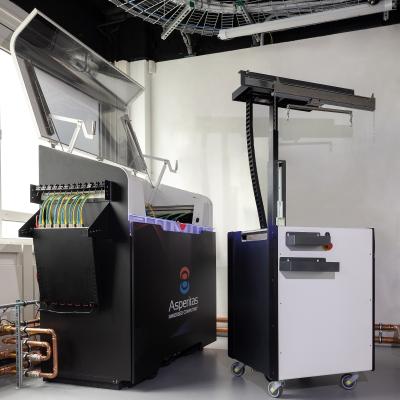-
Immersion cooling could completely change the way data centers are designed.
-
The technique aims to solve the power-density problem data centers are facing due to high-power chips and demanding workloads (hello, AI!).
-
Analysts are expecting a 3-5 year adoption cycle.
July was the hottest month on record - like, ever. Immersion cooling could help data centers beat the heat, but it seems enterprises, not hyperscalers, are leading the charge when it comes to adoption of the technology, two experts told Silverlinings.
“Immersion cooling accounts for about a third of liquid cooling today,” Dell’Oro Group Research Director Lucas Beran said. He added the broader global liquid cooling market is expected to grow to an estimated $1.8 billion in 2027, with immersion cooling accounting for an increasing proportion of the overall market.
Omdia forecast the liquid cooling market to reach $3 billion by 2026, but Beran noted his prediction is specific to data centers and doesn’t include liquid cooling used for things like bitcoin mining.
When can we expect relief from the heat?
Maikel Bouricius, chief commercial officer at liquid cooling company Asperitas, said there’s no doubt hyperscalers are researching immersion cooling techniques. But thus far they’ve hung back as enterprises in the banking, fintech and gaming industries have led the charge.
Beran concurred, stating once hyperscalers take the plunge, “others will follow.”
According to the experts, immersion cooling is just at the start of a three to five-year adoption cycle. North America – home to the big three cloud providers – is moving a bit slower toward immersion cooling than anticipated. But both Beran and Bouricius noted Europe and Asia have been much more aggressive in adopting the technology in part due to regulatory and environmental conditions.
Immersion cooling – a primer

Immersion cooling involves submerging all or parts of a server in liquid. This is usually done using large tanks in place of traditional racks on the data center floor.
According to Beran and Bouricius, there are two primary types of immersion cooling: single phase and two-phase cooling. There’s a little bit of high school chemistry involved in the explanation – if you can remember back that far, think of the three states of matter. That is, solid, liquid and gas.
Beran said single-phase cooling refers to a system in which the liquid used to cool the servers remains in a liquid state. In a two-phase system, however, the cooling liquid evaporates into a gas before being cooled and condensing back into a liquid.
If you’re thinking ‘wait, water and electronics do NOT mix,’ you’re right. They don’t.
Immersion cooling systems use an oil-like liquid. In Asperitas’ case, Bouricius said it uses a natural gas-based liquid it developed alongside fuel company Shell specifically for its single-phase system.
Two-phase systems currently use PFAS-based liquids that are linked to negative health and environmental impacts. Beran said several companies are working to develop new, safer liquids for two-phase systems, but those won’t be ready until 2026 or 2027.
And if you’re now thinking, ‘wait, how are they supposed to do maintenance on servers sitting in oil?” you’re not alone.
Both Beran and Bouricius said operational readiness is the number one hurdle to adoption of immersion cooling.
“With the right tooling and operation procedures, it doesn’t have to be messy or complicated. But it is different,” Bouricius said. “The reality is nobody in data center space is trained for these kinds of environments.”
A specialized tool allows technicians to hoist servers out of a liquid cooling tank without making a mess, but he acknowledged it’s a different way of working.
A whole new cooler world
Immersion isn’t the only form of liquid cooling, but it is currently the only technique that offers a 100% heat capture solution.
For example, a data center operator might use direct-to-chip liquid cooling to cool 70 kilowatts from a 100 kilowatt rack, but they’d still need air cooling for the remaining 30 kilowatts. Immersion, however, could cool all 100 kilowatts, Beran explained.
Immersion cooling also changes the size of the area data centers need to cool, he noted. With air cooling, data center operators need to cool an entire building or room. But with immersion cooling, the immersion tank itself is the only element that needs to be cooled. This has vast implications for greenfield data center design, he concluded.
Read more about data centers in our data center channel here.